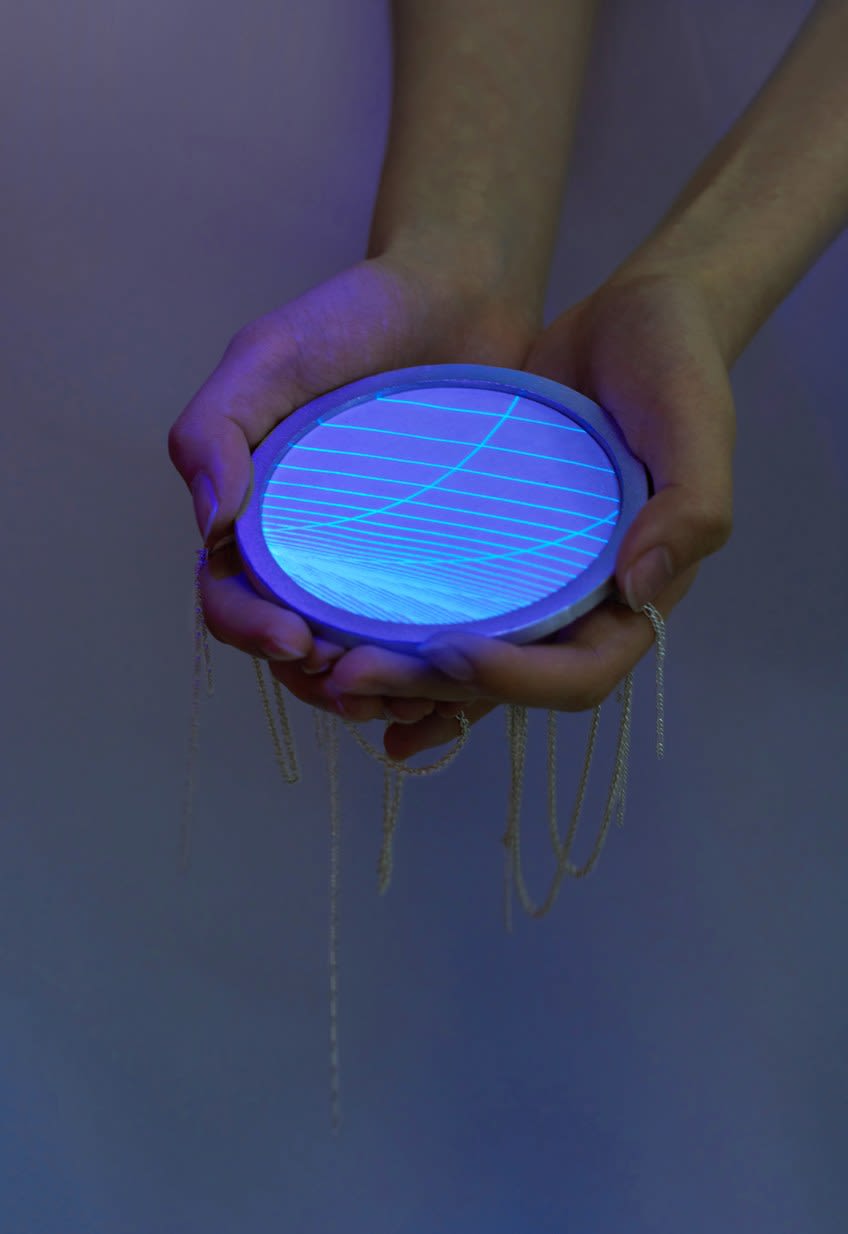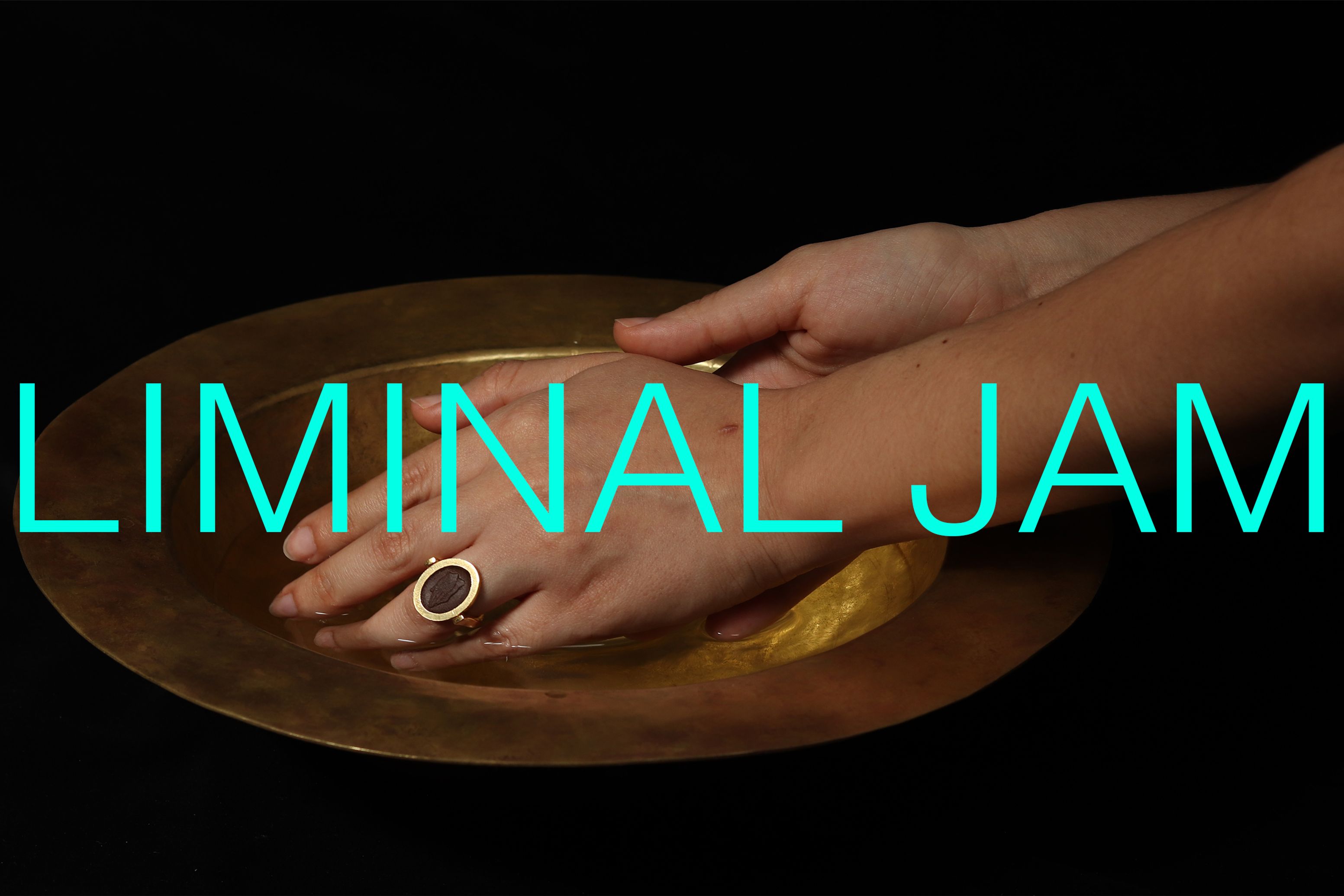I've always liked this story — Chicago has no sea, but the oyster brought the sea.
My work begins with the story of oysters and sea, and aims to show the feeling of those invisible words. I put this story into the silver floppy disk that can be read, and let the story return to the work.
I have always been fascinated by the 'sense of words'. Words seem to me to be more like vessels for the imagination. The narrative nature of words gives me space to imagine.
Paper, books, mobile storage devices, we can naturally associate them with text, even if no text appears on it. Words are to them like Chicago's oysters and sea. Can be seen? Can't be seen? Doesn't seem so important.
In 1954, biologist F. A. Brown dug up a collection of oysters (Ostrea virginica) from the shores of Connecticut and placed them in an aquarium in a basement in Chicago, thousands of miles away. He was a biorhythm researcher, and he knew that oysters lived with the ebb and flow of the tide.
Nothing changed in the first two weeks. The oysters still went about their normal routine, reining in and opening their shells to catch the plankton in the water and feed themselves, following the ebb and flow of the distant coast of Connecticut.
But over the next two weeks, something inexplicable happened. They still rose and fell like the tide, but their high-tide behavior no longer matched that of Connecticut. It's not Florida, it's not California, it's not Dover, it doesn't fit into any of the tidal tables that science knows of.
After repeated calculations, Brown realized one thing: it was high tide in Chicago.
But there is no sea in Chicago.
These oysters lived in reinforced concrete basements, in glass boxes of artificial seawater. But they knew the sea existed. Their ancestors had lived by the sea for hundreds of millions of years. They can leave the sea, but the sea will not leave them. Brown speculated that the oysters may have sensed the change in air pressure, which in turn extrapolated the timing of the tides and their own rhythms. No oyster is consciously doing all this — but in some deep sense they are imagining a sea like this. A sea that does not exist anywhere on earth, where the tides rises and falls, and they open and closed to its rhythm.
Chicago has no sea, but the oyster brought the sea.
References: F. A. Brown, Jr., Persistent Activity Rhythms in The Oyster. The American Journal of Physiology, 1954.


![[untitled]](https://res.cloudinary.com/rca2020/image/upload/f_auto,h_1039,w_1920,c_fill,g_auto,q_auto/v1/rca2021/60be168c379144365895ef80-751097?_a=AXAH4S10)
![[untitled]](https://res.cloudinary.com/rca2020/image/upload/f_auto,h_109,w_1920,c_fill,g_auto,q_auto/v1/rca2021/60be168c379144365895ef80-75138?_a=AXAH4S10)
![[untitled]](https://res.cloudinary.com/rca2020/image/upload/f_auto,h_1402,w_1920,c_fill,g_auto,q_auto/v1/rca2021/60be168c379144365895ef80-159960?_a=AXAH4S10)
![[untitled]](https://res.cloudinary.com/rca2020/image/upload/f_auto,h_1402,w_1920,c_fill,g_auto,q_auto/v1/rca2021/60be168c379144365895ef80-176516?_a=AXAH4S10)
![[untitled]](https://res.cloudinary.com/rca2020/image/upload/f_auto,h_1280,w_1920,c_fill,g_auto,q_auto/v1/rca2021/60be168c379144365895ef80-193091?_a=AXAH4S10)
![[untitled]](https://res.cloudinary.com/rca2020/image/upload/f_auto,h_1280,w_1920,c_fill,g_auto,q_auto/v1/rca2021/60be168c379144365895ef80-202239?_a=AXAH4S10)
![[untitled]](https://res.cloudinary.com/rca2020/image/upload/f_auto,h_1039,w_1920,c_fill,g_auto,q_auto/v1/rca2021/60be22be3791443658961323-848844?_a=AXAH4S10)
![[untitled]](https://res.cloudinary.com/rca2020/image/upload/f_auto,h_262,w_1920,c_fill,g_auto,q_auto/v1/rca2021/60be22be3791443658961323-894342?_a=AXAH4S10)
![[untitled]](https://res.cloudinary.com/rca2020/image/upload/f_auto,h_1402,w_1920,c_fill,g_auto,q_auto/v1/rca2021/60be22be3791443658961323-440109?_a=AXAH4S10)
![[untitled]](https://res.cloudinary.com/rca2020/image/upload/f_auto,h_1402,w_1920,c_fill,g_auto,q_auto/v1/rca2021/60be22be3791443658961323-613612?_a=AXAH4S10)
![[untitled]](https://res.cloudinary.com/rca2020/image/upload/f_auto,h_1402,w_1920,c_fill,g_auto,q_auto/v1/rca2021/60be22be3791443658961323-935860?_a=AXAH4S10)
![[untitled]](https://res.cloudinary.com/rca2020/image/upload/f_auto,h_1280,w_1920,c_fill,g_auto,q_auto/v1/rca2021/60be22be3791443658961323-960025?_a=AXAH4S10)
![[untitled]](https://res.cloudinary.com/rca2020/image/upload/f_auto,h_1402,w_1920,c_fill,g_auto,q_auto/v1/rca2021/60be22be3791443658961323-267402?_a=AXAH4S10)
![[untitled]](https://res.cloudinary.com/rca2020/image/upload/f_auto,h_1280,w_1920,c_fill,g_auto,q_auto/v1/rca2021/60be22be3791443658961323-180323?_a=AXAH4S10)
![[untitled]](https://res.cloudinary.com/rca2020/image/upload/f_auto,h_774,w_1920,c_fill,g_auto,q_auto/v1/rca2021/60be22d1379144365896134e-523980?_a=AXAH4S10)
![[untitled]](https://res.cloudinary.com/rca2020/image/upload/f_auto,h_239,w_1920,c_fill,g_auto,q_auto/v1/rca2021/60be22d1379144365896134e-581648?_a=AXAH4S10)
![[untitled]](https://res.cloudinary.com/rca2020/image/upload/f_auto,h_1153,w_1920,c_fill,g_auto,q_auto/v1/rca2021/60be22d1379144365896134e-609550?_a=AXAH4S10)
![[untitled]](https://res.cloudinary.com/rca2020/image/upload/f_auto,h_2431,w_1920,c_fill,g_auto,q_auto/v1/rca2021/60be22d1379144365896134e-22265?_a=AXAH4S10)
![[untitled]](https://res.cloudinary.com/rca2020/image/upload/f_auto,h_1280,w_1920,c_fill,g_auto,q_auto/v1/rca2021/60be22d1379144365896134e-660854?_a=AXAH4S10)
![[untitled]](https://res.cloudinary.com/rca2020/image/upload/f_auto,h_1280,w_1920,c_fill,g_auto,q_auto/v1/rca2021/60be22d1379144365896134e-736917?_a=AXAH4S10)
![[untitled]](https://res.cloudinary.com/rca2020/image/upload/f_auto,h_1280,w_1920,c_fill,g_auto,q_auto/v1/rca2021/60be22d1379144365896134e-762257?_a=AXAH4S10)
![[untitled]](https://res.cloudinary.com/rca2020/image/upload/f_auto,h_1280,w_1920,c_fill,g_auto,q_auto/v1/rca2021/60be22d1379144365896134e-782763?_a=AXAH4S10)
![[untitled]](https://res.cloudinary.com/rca2020/image/upload/f_auto,h_1280,w_1920,c_fill,g_auto,q_auto/v1/rca2021/60be22d1379144365896134e-817054?_a=AXAH4S10)
![[untitled]](https://res.cloudinary.com/rca2020/image/upload/f_auto,h_1936,w_1920,c_fill,g_auto,q_auto/v1/rca2021/60c0df4137914436589eb59a-52340?_a=AXAH4S10)
![[untitled]](https://res.cloudinary.com/rca2020/image/upload/f_auto,h_2560,w_1707,c_fill,g_auto,q_auto/v1/rca2021/60be231f3791443658961389-411134?_a=AXAH4S10)
![[untitled]](https://res.cloudinary.com/rca2020/image/upload/f_auto,h_2560,w_1707,c_fill,g_auto,q_auto/v1/rca2021/60be231f3791443658961389-422655?_a=AXAH4S10)
![[untitled]](https://res.cloudinary.com/rca2020/image/upload/f_auto,h_2560,w_1706,c_fill,g_auto,q_auto/v1/rca2021/60be231f3791443658961389-432816?_a=AXAH4S10)
![[untitled]](https://res.cloudinary.com/rca2020/image/upload/f_auto,h_2560,w_1707,c_fill,g_auto,q_auto/v1/rca2021/60be231f3791443658961389-473837?_a=AXAH4S10)
![[untitled]](https://res.cloudinary.com/rca2020/image/upload/f_auto,h_2560,w_1706,c_fill,g_auto,q_auto/v1/rca2021/60be231f3791443658961389-502291?_a=AXAH4S10)
![[untitled]](https://res.cloudinary.com/rca2020/image/upload/f_auto,h_2560,w_1707,c_fill,g_auto,q_auto/v1/rca2021/60be231f3791443658961389-764655?_a=AXAH4S10)
![[untitled]](https://res.cloudinary.com/rca2020/image/upload/f_auto,h_2560,w_1707,c_fill,g_auto,q_auto/v1/rca2021/60be231f3791443658961389-699181?_a=AXAH4S10)
![[untitled]](https://res.cloudinary.com/rca2020/image/upload/f_auto,h_2560,w_1707,c_fill,g_auto,q_auto/v1/rca2021/60be231f3791443658961389-718572?_a=AXAH4S10)
![[untitled]](https://res.cloudinary.com/rca2020/image/upload/f_auto,h_1280,w_1920,c_fill,g_auto,q_auto/v1/rca2021/60be231f3791443658961389-669385?_a=AXAH4S10)
![[untitled]](https://res.cloudinary.com/rca2020/image/upload/f_auto,h_1280,w_1920,c_fill,g_auto,q_auto/v1/rca2021/60be231f3791443658961389-677161?_a=AXAH4S10)
![[untitled]](https://res.cloudinary.com/rca2020/image/upload/f_auto,h_2560,w_1707,c_fill,g_auto,q_auto/v1/rca2021/60be232537914436589613a7-881836?_a=AXAH4S10)
![[untitled]](https://res.cloudinary.com/rca2020/image/upload/f_auto,h_2560,w_1709,c_fill,g_auto,q_auto/v1/rca2021/60be232537914436589613a7-740225?_a=AXAH4S10)
![[untitled]](https://res.cloudinary.com/rca2020/image/upload/f_auto,h_2560,w_1707,c_fill,g_auto,q_auto/v1/rca2021/60be232537914436589613a7-870435?_a=AXAH4S10)
![[untitled]](https://res.cloudinary.com/rca2020/image/upload/f_auto,h_2560,w_1707,c_fill,g_auto,q_auto/v1/rca2021/60be232537914436589613a7-969542?_a=AXAH4S10)
![[untitled]](https://res.cloudinary.com/rca2020/image/upload/f_auto,h_2560,w_1709,c_fill,g_auto,q_auto/v1/rca2021/60be232537914436589613a7-988508?_a=AXAH4S10)
![[untitled]](https://res.cloudinary.com/rca2020/image/upload/f_auto,h_2560,w_1707,c_fill,g_auto,q_auto/v1/rca2021/60be232537914436589613a7-3065?_a=AXAH4S10)
![[untitled]](https://res.cloudinary.com/rca2020/image/upload/f_auto,h_2560,w_1707,c_fill,g_auto,q_auto/v1/rca2021/60be232537914436589613a7-688799?_a=AXAH4S10)
![[untitled]](https://res.cloudinary.com/rca2020/image/upload/f_auto,h_1281,w_1920,c_fill,g_auto,q_auto/v1/rca2021/60be232537914436589613a7-145673?_a=AXAH4S10)
![[untitled]](https://res.cloudinary.com/rca2020/image/upload/f_auto,h_1281,w_1920,c_fill,g_auto,q_auto/v1/rca2021/60be232537914436589613a7-164142?_a=AXAH4S10)
![[untitled]](https://res.cloudinary.com/rca2020/image/upload/f_auto,h_1920,w_1920,c_fill,g_auto,q_auto/v1/rca2021/60be2336379144365896141a-428498?_a=AXAH4S10)
![[untitled]](https://res.cloudinary.com/rca2020/image/upload/f_auto,h_1006,w_1920,c_fill,g_auto,q_auto/v1/rca2021/60be2336379144365896141a-324087?_a=AXAH4S10)
![[untitled]](https://res.cloudinary.com/rca2020/image/upload/f_auto,h_1536,w_1920,c_fill,g_auto,q_auto/v1/rca2021/60be2336379144365896141a-445329?_a=AXAH4S10)
